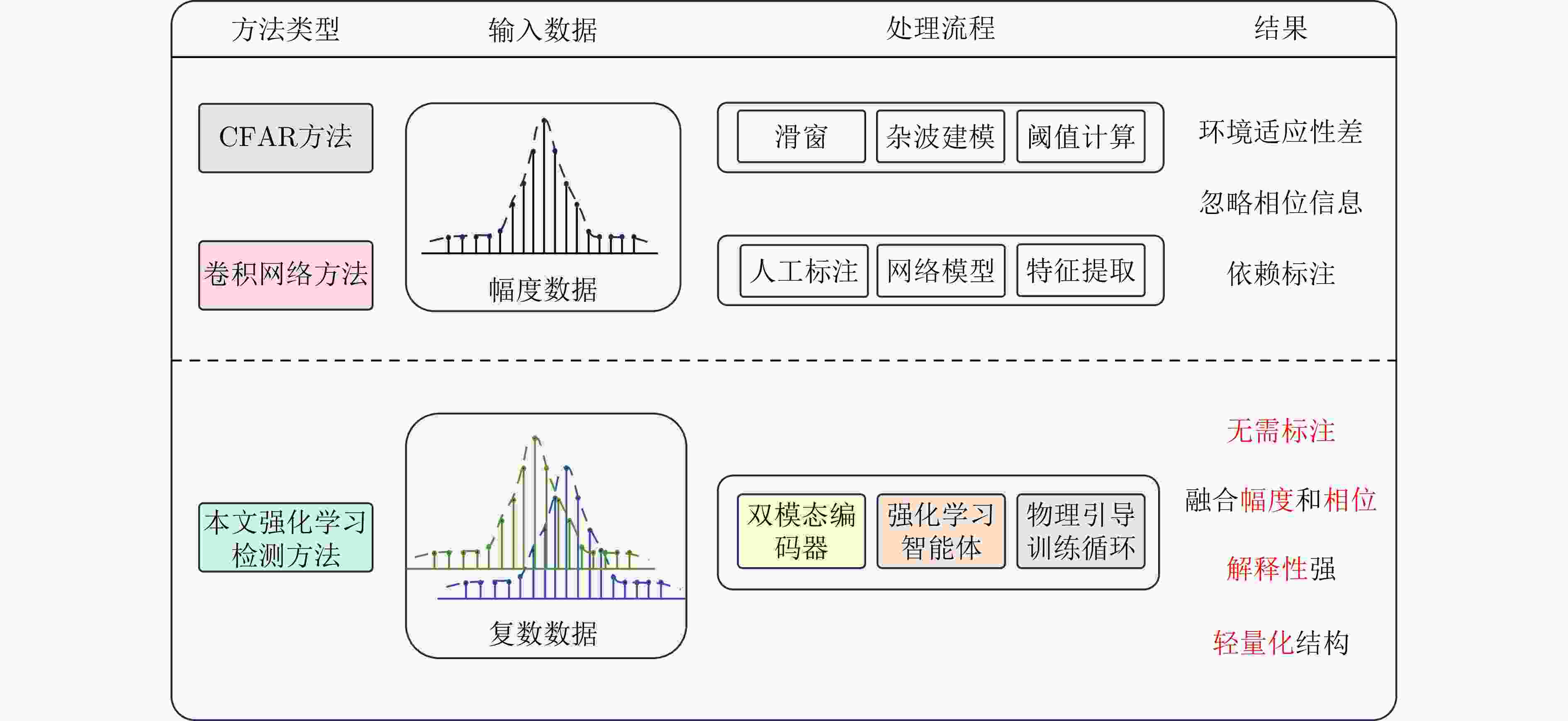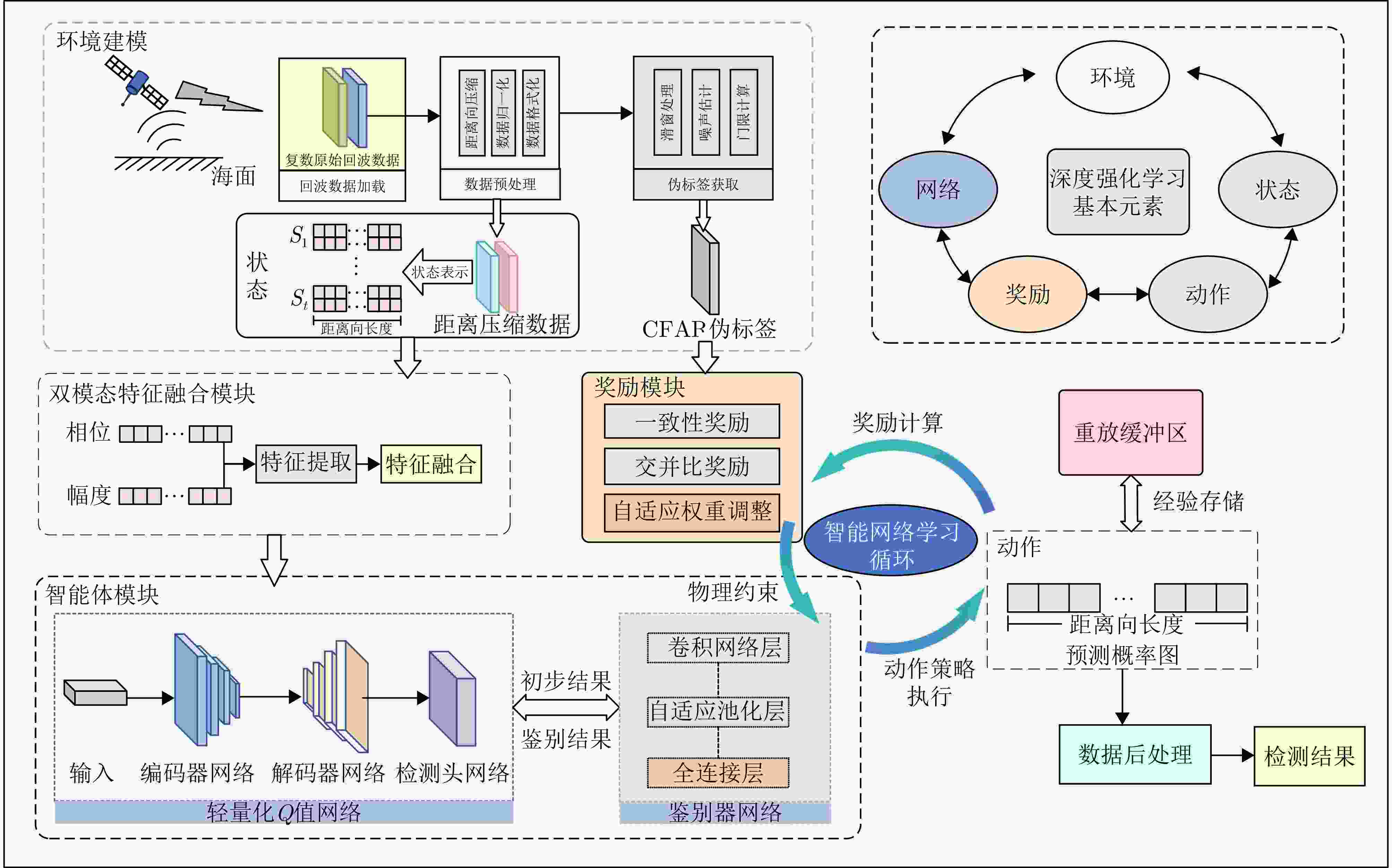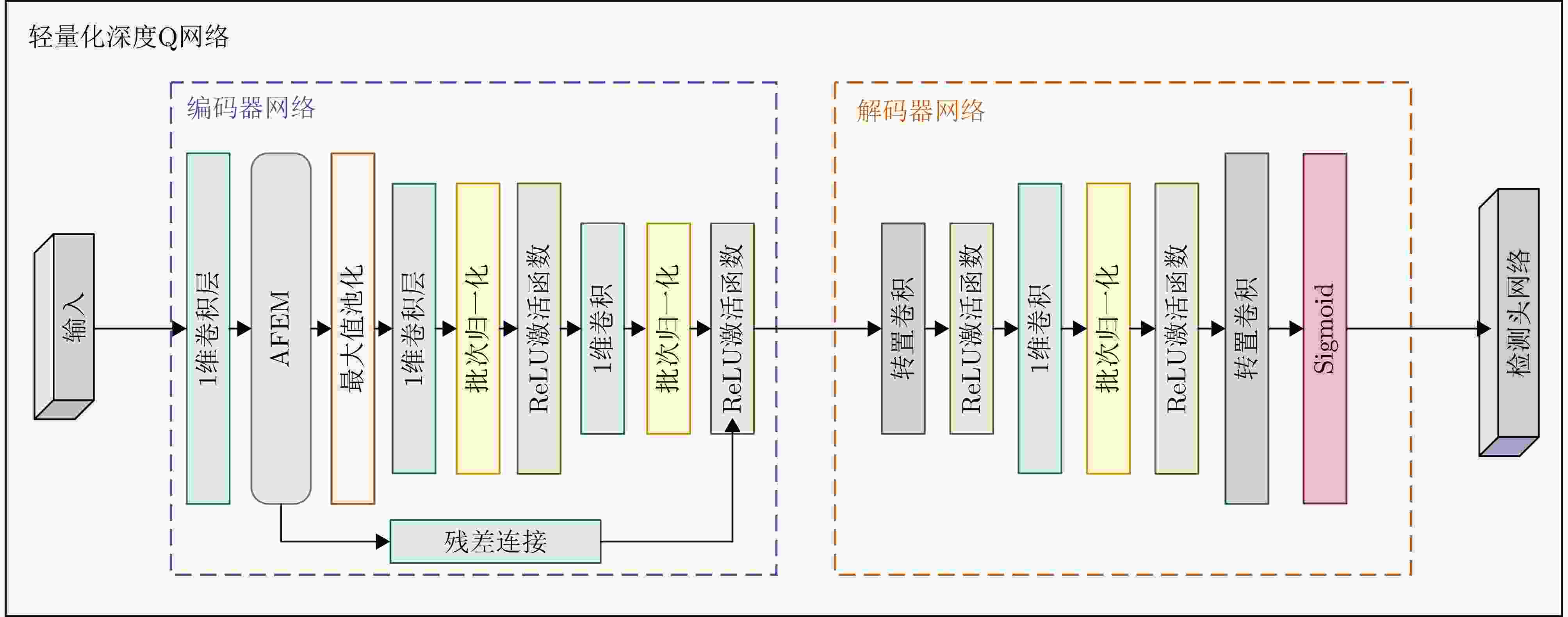Self-Supervised Reinforcement Learning for Ship Detection in SAR Range-Compressed Domain
-
摘要: 合成孔径雷达(SAR)具备全天时全天候的海上监视能力。在距离压缩域(RCD)直接进行舰船目标检测,可规避计算密集的成像步骤(如距离徙动校正与方位压缩),从而显著提升处理效率,适用于近实时或实时处理场景。然而,现有检测方法存在固有局限:一方面,传统恒虚警率(CFAR)检测器依赖于固定统计模型,在复杂海杂波环境下表现不佳;另一方面,深度学习方法普遍存在依赖已标注数据、解释性弱以及相位信息利用不充分等问题。为此,该文提出了一种基于自监督强化学习的SAR距离压缩域舰船目标检测框架,有效融合雷达电磁散射模型与深度强化学习优势,在提升检测性能的同时增强模型的解释性与泛化能力。该框架具有以下特点:(1)引入统计模型约束的奖励信号生成机制,实现了无需人工标注的自监督学习;(2)设计双模态特征融合模块,能够联合表征幅度与相位信息,有效保留舰船的多普勒特征;(3)提出轻量化的智能体模块,集成轻量化Q网络、自适应特征增强模块和鉴别器网络,在降低计算复杂度的同时满足实时处理需求,并借助对抗性训练增强模型的鲁棒性。实验结果表明,所提方法在近20k×20k像素的大场景SAR距离压缩域数据上的平均推理时间仅为31.75 s,计算量仅为二维卷积神经网络的23.81%。在复数RCD数据集上,该方法的F1分数与召回率分别达到50.72%和54.28%,相较于主流自监督检测方法提升了8.76%和10.45%。该研究首次将强化学习引入SAR距离压缩域舰船检测,通过信号模型与数据驱动学习的结合,为实现稳健的海上监视提供了新思路。
-
关键词:
- 合成孔径雷达(SAR) /
- 舰船目标检测 /
- 深度强化学习 /
- 距离压缩域 /
- 自监督检测方法
Abstract: Synthetic aperture radar (SAR) offers all-weather, all-day maritime surveillance capabilities. Direct ship detection in the range compressed domain (RCD) eliminates computationally intensive imaging steps—such as range cell migration correction and azimuth compression—thereby considerably improving processing efficiency for near-real-time or real-time applications. However, current detection methods face inherent limitations; traditional constant false alarm rate detectors rely on fixed statistical models and often underperform in complex sea clutter environments. In addition, deep learning approaches heavily rely on annotated data and do not fully leverage phase information; moreover, they exhibit weak interpretability. To address these issues, this paper proposes a self-supervised reinforcement learning framework for ship target detection in the SAR RCD. This framework effectively integrates the physical principles of radar signals with deep reinforcement learning, achieving enhanced detection performance while improving model interpretability and generalization. The framework has the following characteristics: (1) it introduces a reward signal-generation mechanism constrained by statistical scattering models, achieving self-supervised learning without the need for manual annotation; (2) it designs a dual-modal feature-fusion module that can jointly represent amplitude and phase information, effectively retaining the Doppler characteristics of ships; and (3) it adopts a lightweight agent module that integrates a lightweight Q-network, an adaptive feature enhancement module, and a discriminator network; this module reduces computational complexity, meets real-time processing requirements, and enhances the robustness of the model through adversarial training. Experimental results demonstrate that the proposed method achieves an average inference time of only 31.75 s on a large-scale SAR RCD dataset of 20k × 20k pixels, with a computational load of only 23.81% compared with a two-dimensional convolutional neural network. On a complex-valued RCD dataset, the method attains F1 and recall scores of 50.72% and 54.28%, respectively, outperforming mainstream self-supervised methods by 8.76% and 10.45%, respectively. This study pioneers the application of reinforcement learning to ship detection using SAR RCD, offering a novel approach to robust maritime surveillance by integrating signal modeling and data-driven learning. -
表 1 实验数据集相关信息
Table 1. Information on the experimental dataset
参数名称 指标 总样本数量 8,742 每个样本的距离单元数 1024 舰船数量 14,926 卫星载荷平台 Sentinel-1 极化方式 VV, VH 入射角 20°–45° 表 2 训练超参数配置
Table 2. Training hyperparameter configuration
参数类别 设置值 优化器 Adam 初始学习率 1e-4 学习率调度 余弦退火 批大小(batch size) 32 训练轮次(epoch) 500 CFAR阈值乘数 2.5 超参数调整策略 网格策略 表 3 不同阈值乘数取值下的本文方法检测性能
Table 3. Detection performance under different threshold multiplier values
取值 精确率(%) 召回率(%) F1分数(%) 相对F1变化(%) 1.5 41.20 58.50 48.34 –2.38 2.0 44.82 56.21 49.87 –0.85 2.5 47.60 54.28 50.72 0.00 3.0 48.50 52.13 50.25 –0.47 3.5 50.34 49.78 50.06 –0.66 表 4 消融实验结果
Table 4. The results of the ablation experiment
网络各模块组件 参数量(M) 性能指标(%) 深度强化学习 统计模型约束奖励 双模态融合 鉴别器网络 P R F1 AP@50 – – – – 0.0 31.21 28.72 29.91 33.18 √ – – – 3.01 39.89 42.63 41.21 46.23 √ √ – – 3.01 43.73 48.38 45.93 50.82 √ √ √ – 3.35 46.28 51.73 48.85 53.91 √ √ √ √ 4.49 47.60 54.28 50.72 56.13 表 5 自监督方法比较
Table 5. Comparison of Self-supervised Methods
-
[1] CUMMING I G and WONG F H. Digital Processing of Synthetic Aperture Radar Data: Algorithms and Implementation[M]. Norwood: Artech House, 2005:3-5. [2] 徐丰, 金亚秋. 微波视觉与SAR图像智能解译[J]. 雷达学报(中英文), 2024, 13(2): 285–306. doi: 10.12000/JR23225.XU Feng and JIN Yaqiu. Microwave vision and intelligent perception of radar imagery[J]. Journal of Radars, 2024, 13(2): 285–306. doi: 10.12000/JR23225. [3] 李金灯, 冷祥光, 张思乾, 等. 基于分层模型的单角度SAR舰船目标图像三维形状信息提取技术[J]. 电波科学学报, 2025, 40: 1–15. doi: 10.12265/j.cjors.2025026. (查阅网上资料,未找到本条文献卷期页码信息,请确认).LI Jindeng, LENG Xiangguang, ZHANG Siqian, et al. Three-dimensional shape information extraction technology of ship targets in single-angle SAR images based on layered model[J]. Chinese Journal of Radio Science, 2025, 40: 1–15. doi: 10.12265/j.cjors.2025026. [4] LUO Ru, HE Qishan, ZHAO Lingjun, et al. Geospatial contextual prior-enabled knowledge reasoning framework for fine-grained aircraft detection in panoramic SAR imagery[J]. IEEE Transactions on Geoscience and Remote Sensing, 2024, 62: 5226213. doi: 10.1109/TGRS.2024.3487780. [5] CHEN Mingyao, XIA Jingyuan, LIU Tianpeng, et al. Open set recognition and category discovery framework for SAR target classification based on K-contrast loss and deep clustering[J]. IEEE Journal of Selected Topics in Applied Earth Observations and Remote Sensing, 2024, 17: 3489–3501. doi: 10.1109/JSTARS.2024.3353453. [6] 张强, 王志豪, 王学谦, 等. 基于邻域显著性的可见光和SAR遥感图像海面舰船协同检测方法[J]. 雷达学报(中英文), 2024, 13(4): 885–903. doi: 10.12000/JR24037.ZHANG Qiang, WANG Zhihao, WANG Xueqian, et al. Cooperative detection of ships in optical and SAR remote sensing images based on neighborhood saliency[J]. Journal of Radars, 2024, 13(4): 885–903. doi: 10.12000/JR24037. [7] ZHANG Chi, ZHANG Xi, GAO Gui, et al. Development and application of ship detection and classification datasets: A review[J]. IEEE Geoscience and Remote Sensing Magazine, 2024, 12(4): 12–45. doi: 10.1109/MGRS.2024.3450681. [8] ZHANG Xianghui, ZHANG Siqian, SUN Zhongzhen, et al. Cross-sensor SAR image target detection based on dynamic feature discrimination and center-aware calibration[J]. IEEE Transactions on Geoscience and Remote Sensing, 2025, 63: 5209417. doi: 10.1109/TGRS.2025.3559618. [9] JOSHI S K and BAUMGARTNER S V. Automatic CFAR ship detection in single–channel range-compressed airborne radar data[C]. 2019 20th International Radar Symposium (IRS), Ulm, Germany, 2019: 1–8. doi: 10.23919/IRS.2019.8768137. [10] LENG Xiangguang, JI Kefeng, and KUANG Gangyao. Ship detection from raw SAR echo data[J]. IEEE Transactions on Geoscience and Remote Sensing, 2023, 61: 5207811. doi: 10.1109/TGRS.2023.3271905. [11] LI Jianwei, CHEN Jie, CHENG Pu, et al. A survey on deep-learning-based real-time SAR ship detection[J]. IEEE Journal of Selected Topics in Applied Earth Observations and Remote Sensing, 2023, 16: 3218–3247. doi: 10.1109/JSTARS.2023.3244616. [12] 崔宗勇, 王晓雅, 施君南, 等. 基于中心点回归的大场景SAR图像舰船检测方法[J]. 电波科学学报, 2022, 37(1): 153-161. doi: 10.12265/j.cjors.2020205.CUI Zongyong, WANG Xiaoya, SHI Junnan, et al. Ship detection in large scene SAR images based on target center point regression [J]. Chinese journal of radio science, 2022, 37(1): 153-161. (in Chinese). DOI: 10.12265/j.cjors.2020205. [13] TAN Xiangdong, LENG Xiangguang, SUN Zhongzhen, et al. Lightweight ship detection network for SAR range-compressed domain[J]. Remote Sensing, 2024, 16(17): 3284. doi: 10.3390/rs16173284. [14] 韩子硕,王春平,付强,等. 联合生成对抗网络和检测网络的SAR图像目标检测[J]. 国防科技大学学报, 2022, 44(3): 164–175. doi: 10.11887/j.cn.202203020.HAN Zishuo, WANG Chunping, FU Qiang, et al. Target detection in SAR images based on joint generative adversarial network and detection network[J]. Journal of National University of Defense Technology, 2022, 44(3): 164–175. doi: 10.11887/j.cn.202203020. [15] SUN Zhongzhen, LENG Xiangguang, ZHANG Xianghui, et al. Arbitrary-direction SAR ship detection method for multiscale imbalance[J]. IEEE Transactions on Geoscience and Remote Sensing, 2025, 63: 5208921. doi: 10.1109/TGRS.2025.3559701. [16] TAN Xiangdong, LENG Xiangguang, LUO Ru, et al. YOLO-RC: SAR ship detection guided by characteristics of range-compressed domain[J]. IEEE Journal of Selected Topics in Applied Earth Observations and Remote Sensing, 2024, 17: 18834–18851. doi: 10.1109/JSTARS.2024.3478390. [17] WANG Chao, GUO Baolong, SONG Jiawei, et al. A novel CFAR-based ship detection method using range-compressed data for spaceborne SAR system[J]. IEEE Transactions on Geoscience and Remote Sensing, 2024, 62: 5215515. doi: 10.1109/TGRS.2024.3419893. [18] LORAN T, DA SILVA A B C, JOSHI S K, et al. Ship detection based on faster R-CNN using range-compressed airborne radar data[J]. IEEE Geoscience and Remote Sensing Letters, 2023, 20: 3500205. doi: 10.1109/LGRS.2022.3229141. [19] GAO Yuze, LI Dongying, GUO Weiwei, et al. SAR ship detection in range-compressed domain based on LSTM method[C]. IGARSS 2023-2023 IEEE International Geoscience and Remote Sensing Symposium, Pasadena, USA, 2023: 6422–6425. doi: 10.1109/IGARSS52108.2023.10282810. [20] ZENG Hongcheng, SONG Yutong, YANG Wei, et al. An Incept-TextCNN model for ship target detection in SAR range-compressed domain[J]. IEEE Geoscience and Remote Sensing Letters, 2024, 21: 3501305. doi: 10.1109/LGRS.2024.3351745. [21] AI Jiaqiu, QI Xiangyang, YU Weidong, et al. A new CFAR ship detection algorithm based on 2-D joint log-normal distribution in SAR images[J]. IEEE Geoscience and Remote Sensing Letters, 2010, 7(4): 806–810. doi: 10.1109/LGRS.2010.2048697. [22] LI Tao, PENG Dongliang, CHEN Zhikun, et al. Superpixel-level CFAR detector based on truncated gamma distribution for SAR images[J]. IEEE Geoscience and Remote Sensing Letters, 2021, 18(8): 1421–1425. doi: 10.1109/LGRS.2020.3003659. [23] 张帆, 陆圣涛, 项德良, 等. 一种改进的高分辨率SAR图像超像素CFAR舰船检测算法[J]. 雷达学报, 2023, 12(1): 120–139. doi: 10.12000/JR22067.ZHANG Fan, LU Shengtao, XIANG Deliang, et al. An improved superpixel-based CFAR method for high-resolution SAR image ship target detection[J]. Journal of Radars, 2023, 12(1): 120–139. doi: 10.12000/JR22067. [24] LI Mingdian, CUI Xingchao, and CHEN Siwei. Adaptive superpixel-level CFAR detector for SAR inshore dense ship detection[J]. IEEE Geoscience and Remote Sensing Letters, 2022, 19: 4010405. doi: 10.1109/LGRS.2021.3059253. [25] ZHAO Qixin, ZHANG Zhiguo, WEI Zixiang, et al. Statistical analysis of typical clutter scenes in high resolution SAR images[C]. 2019 14th IEEE Conference on Industrial Electronics and Applications (ICIEA), Xi'an, China, 2019: 1101–1105. doi: 10.1109/ICIEA.2019.8833782. [26] XING Xiangwei, JI Kefeng, ZOU Huanxin, et al. High resolution SAR imagery ship detection based on EXS-C-CFAR in Alpha-stable clutters[C]. 2011 IEEE International Geoscience and Remote Sensing Symposium, Vancouver, Canada, 2011: 316–319. doi: 10.1109/IGARSS.2011.6048956. [27] LI Hengchao, KRYLOV V A, FAN Pingzhi, et al. Unsupervised learning of generalized gamma mixture model with application in statistical modeling of high-resolution SAR images[J]. IEEE Transactions on Geoscience and Remote Sensing, 2016, 54(4): 2153–2170. doi: 10.1109/TGRS.2015.2496348. [28] LENG Xiangguang, JI Kefeng, YANG Kai, et al. A bilateral CFAR algorithm for ship detection in SAR images[J]. IEEE Geoscience and Remote Sensing Letters, 2015, 12(7): 1536–1540. doi: 10.1109/LGRS.2015.2412174. [29] TAO Ding, ANFINSEN S N, and BREKKE C. Robust CFAR detector based on truncated statistics in multiple-target situations[J]. IEEE Transactions on Geoscience and Remote Sensing, 2016, 54(1): 117–134. doi: 10.1109/TGRS.2015.2451311. [30] PAPPAS O, ACHIM A, and BULL D. Superpixel-level CFAR detectors for ship detection in SAR imagery[J]. IEEE Geoscience and Remote Sensing Letters, 2018, 15(9): 1397–1401. doi: 10.1109/LGRS.2018.2838263. [31] JOSHI S K, BAUMGARTNER S V, DA SILVA A B C, et al. Range-Doppler based CFAR ship detection with automatic training data selection[J]. Remote Sensing, 2019, 11(11): 1270. doi: 10.3390/rs11111270. [32] LENG Xiangguang, WANG Jin, JI Kefeng, et al. Ship detection in range-compressed SAR data[C]. IGARSS 2022-2022 IEEE International Geoscience and Remote Sensing Symposium, Kuala Lumpur, Malaysia, 2022: 2135–2138. doi: 10.1109/IGARSS46834.2022.9884909. [33] CAICEDO J C and LAZEBNIK S. Active object localization with deep reinforcement learning[C]. IEEE International Conference on Computer Vision, Santiago, Chile, 2015: 2488–2496. doi: 10.1109/ICCV.2015.286. [34] BUENO M B, GIRO-I-NIETO X, MARQUÉS F, et al. Hierarchical object detection with deep reinforcement learning[M]. HEMANTH D J, ESTRELA V V. Deep Learning for Image Processing Applications. Amsterdam: IOS Press, 2017: 164–176. doi: 10.3233/978-1-61499-822-8-164. [35] PIRINEN A and SMINCHISESCU C. Deep reinforcement learning of region proposal networks for object detection[C]. IEEE/CVF Conference on Computer Vision and Pattern Recognition, Salt Lake City, USA, 2018: 6945–6954. doi: 10.1109/CVPR.2018.00726. [36] 杜兰, 王梓霖, 郭昱辰, 等. 结合强化学习自适应候选框挑选的SAR目标检测方法[J]. 雷达学报, 2022, 11(5): 884–896. doi: 10.12000/JR22121.DU Lan, WANG Zilin, GUO Yuchen, et al. Adaptive region proposal selection for SAR target detection using reinforcement learning[J]. Journal of Radars, 2022, 11(5): 884–896. doi: 10.12000/JR22121. [37] CHEN Xinlei, FAN Haoqi, GIRSHICK R, et al. Improved baselines with momentum contrastive learning[J]. arXiv: 2003.04297, 2020. doi: 10.48550/arXiv.2003.04297. (查阅网上资料,不确定文献类型及格式是否正确,请确认). [38] CHEN Ting, KORNBLITH S, NOROUZI M, et al. A simple framework for contrastive learning of visual representations[C]. The 37th International Conference on Machine Learning, 2020: 1597–1607. (查阅网上资料,未找到本条文献出版地信息,请确认). [39] BAR A, WANG Xin, KANTOROV V, et al. DETReg: Unsupervised pretraining with region priors for object detection[C]. IEEE/CVF Conference on Computer Vision and Pattern Recognition, New Orleans, USA, 2022: 14585–14595. doi: 10.1109/CVPR52688.2022.01420. [40] DAI Zhigang, CAI Bolun, LIN Yugeng, et al. Up-detr: Unsupervised pre-training for object detection with transformers[C]//Proceedings of the IEEE/CVF conference on computer vision and pattern recognition. 2021: 1601-1610. doi: 10.1109/cvpr46437.2021.00165. -



 作者中心
作者中心 专家审稿
专家审稿 责编办公
责编办公 编辑办公
编辑办公

 下载:
下载:







